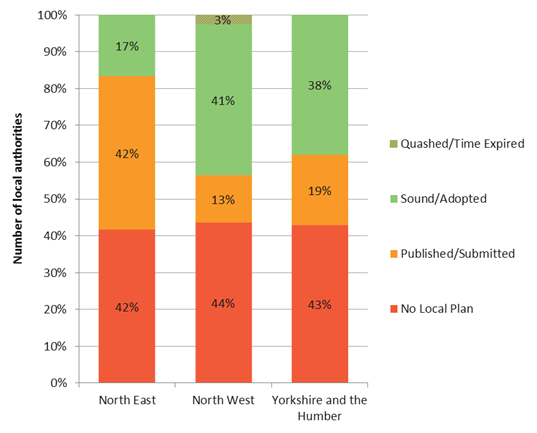In a recent conversation with one of my clients, he laid down a challenge for me to name a movie sequel that was better than the original. It’s a more difficult question to answer than you might think.
Gavin Barwell must have felt similar when Theresa May asked him to sort out the housing crisis.
When it finally arrived, the much-delayed Housing White Paper, titled Fixing our Broken Housing Market, had good intention but was surrounded by rumours of last minute edits and alterations.
Given the timing of its release, and with the local elections taking place today across the country, it is of no surprise that the version we have all submitted responses to the day before yesterday is a very politically astute document. It ended up saying something for everyone, and was all things to all men, or was it?
A notable absentee is the eagerly anticipated standardised approach for all local planning authorities to follow to determine their Objectively Assessed Housing Need – a vital methodology for calculating housing requirement, which could have huge implications for local authorities across the North East.
This methodology was supposed to be in the White Paper, and then it was supposed to be released during the consultation on the White Paper. The fact that we are still waiting suggests that the government are perhaps struggling to come up with a sequel that is better than the original!
The White Paper does set out some positive steps, including the potential for planning departments to get additional resource through higher fees, pushing for better use of public sector land and working to get more SME housebuilders into the sector.
However, a leading role in the White Paper is the Local Authority. There are certainly great expectations placed on local authorities to deliver more housing in their patch, with financial incentives in return on offer.
Indeed, there is great scope and opportunity for the local authorities to be more innovative in leading housing delivery. Currently the release of public sector land via estate and asset management plans is slow and onerous – and what does ‘best value’ really mean? Local Authorities need to remove the shackles and allow potential housing sites to come to the market much faster and free from restrictive processes and criteria. Local authorities could also look at supporting SME housebuilders (who are seen by Gavin Barwell as having a key supporting role to the national housebuilders) through financing the implementation of suitable housing sites.
As I mentioned, the White Paper is a politically astute document – and politics at the local authority level continues to be a significant issue that is holding housing delivery back. Planning Committees need to play a more proactive role in bringing suitable housing developments forward. On too many occasions suitable proposals are being refused by planning committees against recommendations for approval by their own officers, resulting in planning by appeal. Whilst ‘training’ for planning committee members does take place in more local authorities, I would like to see more stringent performance management measures introduced by local authorities to ensure their Members make sound decisions based on planning, not vote scoring. Where Councillors fail to make sound planning judgements they could be removed from planning committee for a period of time and given more training.
The White Paper confirms that planning application fees will be on the increase by 20% from July, which will generate additional income for local authorities. As an extra incentive for those authorities that proactively deliver housing then they could be able to charge an additional 20% on their fees. There are many of my private sector clients who regularly say to me that they would be happy to pay local authorities more for a planning application fee or for pre-app, as long as it guaranteed a better service. It’s a real pity that the public sector cannot provide the service the private sector expects in the first place; but with local authorities continuing to lose experienced planning officers who deal with applications in a pragmatic and positive way, is it really a surprise they are struggling to deal with major development proposals that are desperately needed quickly to address housing needs and demand?
More money coming into a local authority does not address that loss of experience; with the possibility of the local authority receiving extra finances I only see the Finance Director being the main beneficiary in order to cover the coffers across a number of Council departments to address the wider squeeze on public sector budgets.
It is vital that any extra revenue local authorities generate through planning applications it benefits not just the development management departments – the planning policy team is equally important, as the Local Plan is a pivotal platform for housing delivery. Unfortunately as our analysis shows the pace at which the Northern local authorities are finalising their respective local plan continues to be pedestrian at best.

Given the importance of early engagement between developers and the local planning authority, it is vital that each local authority has a recognised figurehead as a head of planning policy and head of development management. Demonstrating this leadership provides confidence to the development industry. However, it is alarming to note that 33% of North East local authorities do not have a Head of Planning Policy whose sole purpose is to get a sound Local Plan in place and successfully implement it. There is also a Head of Development Management missing in 25% of the region’s local authorities. It is vital that these vacancies are occupied with experienced, recognisable planners who can be the leading actor for the respective authority.
Talking of figureheads, not only is it the local elections today, but May the Fourth brings ‘A New Hope’ with a new Mayor for the Tees Valley. This strategic overview for a number of key policy areas is crucial to the success of a sub-region like the Tees Valley. Housing has a key role to play in delivering the national Industrial Strategy, and the Tees Valley must see housing as an essential component of infrastructure in the same way as transport, energy and higher education.
There have been several previous attempts at sub-regional working – even Tyne & Wear had a go in 1977 (the same year George Lucas brought Star Wars to the big screen for the first time) with the Tyne & Wear Development Plan – and it is a great shame that 7 North East authorities have continued to fail to reach a pragmatic solution to collaboration. With the potential of the Housing Infrastructure Fund on offer, prioritisation for housing and economic development beyond administrative boundaries is crucial to the wider benefit of the North East. Whilst the three authorities north of the Tyne continue to broker a deal, the silence from the authorities south of the Tyne is alarmingly deafening.
The Tees Valley however continue to make hay whilst the sun shines, and whilst it is not always easy to agree on the priorities across five local authority areas, I am sure with Sue Jeffrey, a former colleague of mine, as the Mayor, that the Force will Awaken, and the Tees Valley will continue to demonstrate to the Government how devolving powers locally can work.
Whilst collaboration across local authorities is important, collaboration between local authorities and the development industry is equally important. At Lichfields we have been working closely with the HBF to engage with local authorities across the North East to share intelligence on the issues both sectors face whilst both trying to bring housing forward. With the likes of Darlington, Northumberland and Sunderland this engagement has proved useful – but it has demonstrated that it must be the start of a continuous dialogue. We want other local authorities (officers and Members) to proactively engage. Through our work with the North East Chamber of Commerce on housing I would also advocate the establishment of a developers’ forum where the ties between the wider housing industry and local planning authorities are also strengthened.
Whilst progress has been made in bringing forward more housing, we must continue to do more. This can be achieved with the right policy and investment frameworks in place. It will be an interesting summer ahead to see the fallout from the Housing White Paper, and I hope the distraction of 8 June does not affect the momentum that has been generated in ensuring housing delivery and economic ambition is achieved through practical policies and proposals.
Image credit: LUCASFILM




